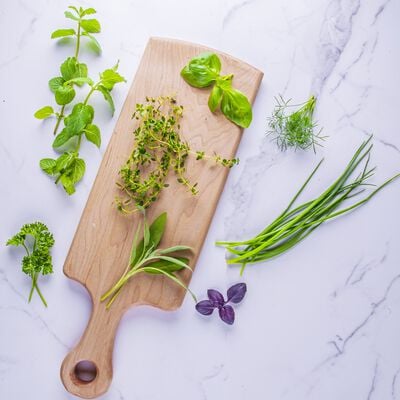
How do I Harvest, Dry, or Store my Herbs?
Begin your herb harvests sooner than you think.
Harvesting
You can find information about harvesting your salad greens and herb kitchen garden in our previous Indoor Gardening Month articles. Great information here on how to prune and harvest without impacting the health of your plants!
Some herbs germinate and grow faster than others, but you can benefit by beginning harvests much earlier than you think. Most herbs develop bushier growth when you harvest early -- so as soon as you can trim a stem here or a leaf or two there, start enjoying herbs on your salads, or a handful in soups or sauces. You'll actually get more herbs in the long run if you start gently trimming them back early.
Storing
If you harvest more herbs than you can use right away, you can store them in the refrigerator for several days. Some of the high water content herbs such as basil, parsley, savory, cilantro, chervil and mint keep best if stored upright in the refrigerator with their leaves kept relatively dry, but with their stems in water. Most of the low water content herbs such as sage, dill, savory, oregano and thyme prefer to be stored in unsealed bags in the fridge, with a piece of paper towel inside the bag to absorb condensation and to moderate humidity. These methods are only good if you plan on using your leftover herbs relatively quickly, like within a few days.
Drying Herbs in the Microwave - Quick and Easy!
-- Place a microwave-safe cup half-full of water in the microwave. (Do not put the herbs in the water, the cup of water is to protect microwave from damage if the herbs do not contain enough moisture).
-- Spread a couple of handfuls of cleaned herb leaves or sprigs evenly on a double layer of paper towels.
-- Microwave on 'High' for 1 minute.
-- Inspect the herbs, and remove any dry, crisp leaves.
-- Repeat for 30-second intervals until all herbs are dry and crisp.
-- Strip the dried leaves from the stems, crumble (or not) and store in a small airtight jar.
Use about a teaspoon of crumbled dry leaves in place of a tablespoon of fresh herbs.
Drying Herbs - Traditional Method
All herbs can be dried successfully with the proper technique, but the easiest herbs to dry are those with lower water-content: sage, dill, savory, oregano and thyme. If you want to dry the juicier herbs such as basil, cilantro and mint, extra care must be taken to make sure they do not develop mold before they dry completely.
To dry herbs, harvest whole stems (with leaves intact) and bundle 4-6 stems together at the base with a rubber band. Make sure the rubber band is tight enough to continue to hold the herb stems as they dry and shrink. Take a small brown paper bag, label it with the name and harvest date of the herb, and poke quite a few holes in the bag for air circulation. Open the bag fully to allow for maximum air flow. Place the herb bundle upside down in the bag, and gather the opening of the bag around the stem ends, tying them up together with a piece of string. Make sure the herbs are not too crowded in the bag, or mold can result.Hang the bag so that the herbs are upside down in a warm room with good air circulation. The bag will help absorb moisture and wick it away from the plants, as well as protect the herbs from light, which will help assure maximum retention of flavor.
Check the herbs inside the bag in about two weeks to see how they are drying. Check every week or so until they are completely, crispy dry before placing them in airtight containers for longer-term storage. Zip-close bags will work, but glass jars with tight-fitting lids are preferable, as they are more airtight than plastic bags. Again, make absolutely sure the herbs are bone dry before placing them in airtight containers. Remove the leaves from the stems when they are dry, and store the leaves whole until ready to use. The leaves will retain more essential oil and therefore more flavor if left in whole-leaf form until ready to use.
Use about a teaspoon of crumbled dry leaves in place of a tablespoon of fresh herbs.
Freezing

Freezing herbs is just as easy as drying them. Frozen herbs keep their fragrance and flavor for 3 - 4 months and are ideal for adding to soups, stews, braised dishes and sauces. Chives don't freeze well, try drying them instead.
To make herbal ice cubes:
-- Fill one or more sections of an ice cube tray 3/4 full with chopped herb leaves, cover with water or olive oil and place in freezer.
-- When frozen, remove the herbal ice cubes and place in a labeled freezer bag
-- To use, just toss the herbal ice cubes into your sauce or dish and taste as it cooks, adding more herbs as needed.
You can freeze whole sprigs of herbs simply by layering them in self closing freezer bags (not too many layers) and laying them flat in the freezer. Place quart-size bags of herbs in one gallon-size bag to consolidate. Now you can use only what you need when you need it.
Don't expect to use frozen herbs as a fresh garnish - they will turn black as they thaw.
CLICK HERE FOR MORE INFO ON HERBS

